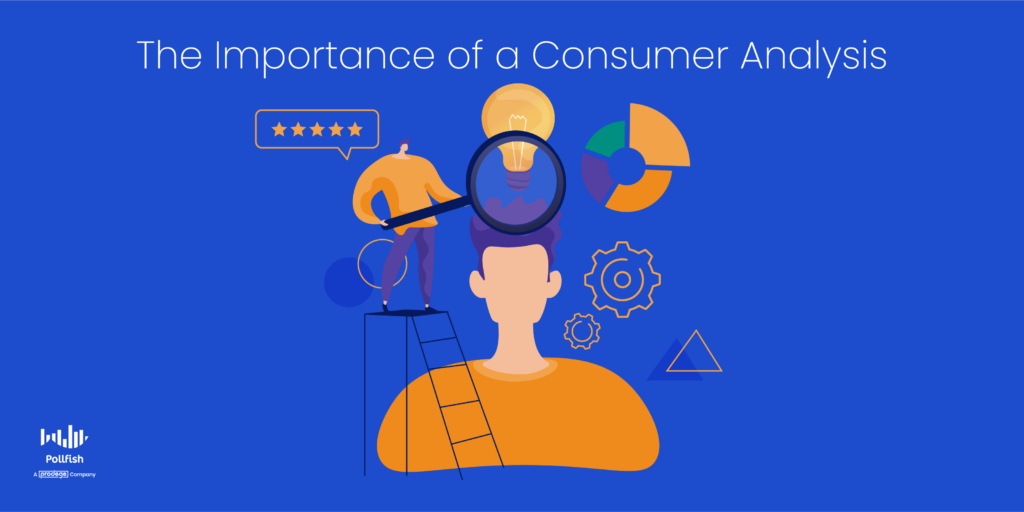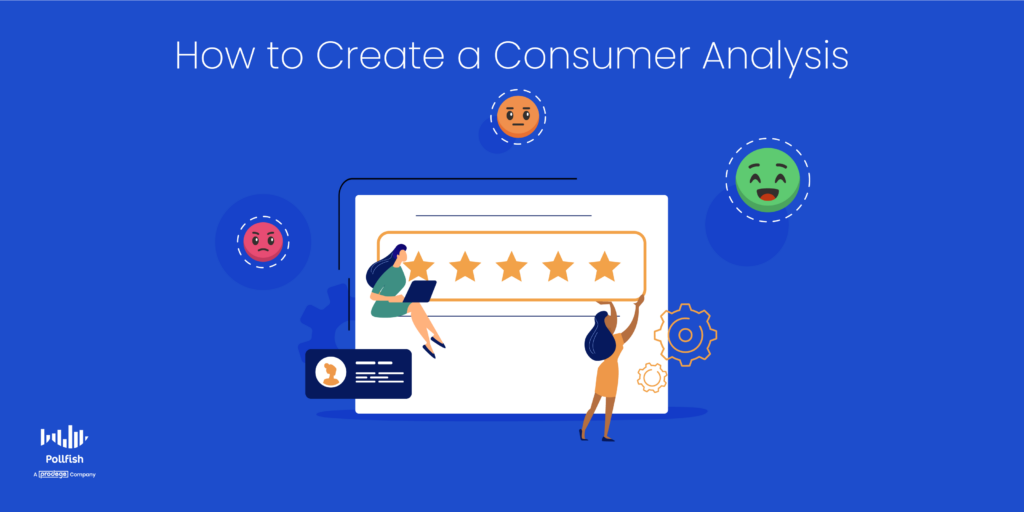How to Conduct a Consumer Analysis for Business Growth

All businesses need to conduct a consumer analysis to achieve any sort of industry success, as it is largely dependent on customer satisfaction. Given that customers are the lifeblood of any business, you should never invest in any marketing or outreach campaign before examining your target market.
76% of customers expect companies to understand their needs. However, only 17% of customers believe that businesses listen to their feedback. This grim statistic highlights the fact that many brands simply don’t use the data they collect, if they collect any at all.
To carry out consumer analysis, brands should not merely gather data from their websites; they need to execute market research, a kind of research that places consumer data at the fore. Consumer analysis is key to the broader practice of market research.
Unfortunately, only 19% of brands conduct consumer analysis, properly segment their audiences and personalize their offers. As such, it is understandable why less than one-fifth of consumers believe brands are listening to them.
This article expounds on consumer analysis, its importance, how to conduct it and how to use market research to perform it.
Understanding Consumer Analysis
Consumer analysis refers to the process of gaining detailed consumer information, typically through market research techniques, which focus on the customer aspect of market analysis.
A consumer analysis involves identifying a target market and its different segments, understanding customer behavior, along with consumer preferences and anything else that affects how customers interact and patronize a business.
To conduct a consumer analysis, businesses need to collect data beyond their websites. This does not end with examining purchase data, returns, payments and advertising costs, as it largely depends on studying the customers themselves.
As such, it involves tracking customer buying behavior, their desires, dislikes, lifestyle, aversions, needs and more.
The purpose of taking part in a consumer analysis is to investigate the portion of any population that is most likely to purchase your products or services, which is typically called a target market. By establishing different groups of consumers and understanding their needs, you can properly cater to them and build consumer loyalty.
The Parts of a Consumer Analysis
This kind of analysis carries several objectives, which the following lays out:
- Producing a profile of consumers: This involves demographic, psychographic, economic, social and geographical characteristics of the consumers.
- It also includes any of their special interests and habits.
- It covers the consumer buying process, which involves how they make their decisions, the time and frequency of their purchase, how they purchase and how they pay.
- Customer profiles can take the form of fictional, yet representational buyers called customer personas.
- Benefits gained by the consumers: These include various benefits that a brand derives from potential and current customers.
- It includes monetary benefits, psychological benefits and high and low involvement benefits, which depend on the products.
- It also encompasses purchaser benefit depending on whether you operate a B2B or B2C business.
- The business’s role in meeting the consumers’ needs: This includes an analysis of your business itself in relation to customers’ needs, pain points and problems.
- You must be able to answer how your business is able to resolve your customers’ problems.
- After identifying different segments and personas, you should rationalize how each group can specifically benefit from your offerings.
The Importance of Consumer Analysis
This kind of analysis is important for several reasons, which carry benefits for your business.
First off, it is necessary for the founding document of a business: the business plan. This kind of analysis is a decisive component of any business plan and in all stages of growth. That’s because this kind of analysis identifies your target market, its value and how your business is particularly equipped to help its target market members.
Forging brand awareness is key for business growth; as such, businesses often spend much of their budget on marketing. Not all channels bring in the same foot traffic and some have higher bounce rates than others. A consumer analysis creates marketing efficiency, as it allows you to understand consumer preferences when it comes to marketing channels and content marketing strategy.
This kind of analysis also allows businesses to be well aware of the motivational factors behind their customers’ purchases. By understanding what motivates consumers to make a purchase, you can improve your business strategies by understanding how to cater to those motivations and needs.

Piggybacking off of the need to understand what motivates your consumers to buy, a consumer analysis helps you increase sales. By understanding the motivations behind purchases, you can market your products and services far more proactively.
This is because by thoroughly analyzing your customers, you’ll be able to tap into their biggest needs and strongest opinions. Knowing these will ensure you avoid negative associations for your consumers while understanding what will have positive effects. This includes understanding cultural trends, along with logistical aspects, such as shipping times.
A consumer analysis can even help improve your profit margins. This is because not every customer is built the same in terms of buying behavior and most importantly, customer lifetime value (CLV). Some consumers will buy from your brand a few times a year, while others may do so on a more regular basis. Other consumers will bring in one-fourth in revenue throughout their relationship with your business, therefore bringing a higher CLV.
By analyzing your different segments and personas, you’ll be able to see which ones are worth marketing certain products/services to. It will also help you adjust your pricing plans accordingly and innovate to suit particular consumer segments.
Finally, this kind of analysis is critical for building and maintaining customer retention, which keeps your business afloat, as it is less expensive to sell to existing customers. By examining your consumers and being attuned to all their quirks and needs, you’ll be able to satisfy them. Doing so on a consistent basis will strengthen your consumer loyalty and enable you to increase your customer retention rate.
How to Conduct a Consumer Analysis with Market Research
Conducting a consumer analysis involves studying your consumers closely after identifying them. As such, there are different approaches to performing this kind of analysis. We stress the importance of market research for completing such an analysis, as it involves the means for gaining the insights you’ll need.
The analysis we put together involves using a market research platform as the main vessel for extracting consumer insights.

The following explains how to conduct a consumer analysis:
- Put together a preliminary list of the demographics you suspect to be in your target market.
- Add in inferences about location and psychographic preferences.
- Perform secondary research on these groups for further information and identification.
- Use a market research platform to conduct primary research on your consumers.
- Create surveys that ask questions that allow you to segment your consumers into different segments based on their demographics, location, lifestyle, buying behaviors and habits.
- Probe further into their psychographics by asking questions about what annoys them and distresses them, along with what they like, desire and prefer, particularly in regards to your niche and products/services.
- Once you have segmented your consumers via the market segmentation methods laid out above, form surveys that address their problems.
- This will allow you to understand how to position your brand favorably and as the solution to their problems and supplier of their needs.
- Create follow-up questions to understand the needs of your consumers, along with what they’re currently doing to meet their needs.
- Ask about their preferences in regards to price, brands and other considerations. For example, the model of a product, its year of release, etc.
- Use the data you garnered as a means to assign value to your different consumer segments.
- It may be too early to calculate your customer lifetime value, unless you’ve already analyzed your consumers previously.
- This is especially true if you’re conducting this analysis in a well-established business, or at least in the aftermath of a business plan.
- Analyze all your data in the dashboard of your online survey platform.
- You should use a platform that offers different visualizations and export options of the data, so that you can share it across your team and truly form data democratization.
- Analyze your own brand in relation to your consumers.
- What are your strongest selling points, especially in regards to your consumer insights?
- How can you help them the most?
- Or, how can you market yourself to point out that you help with all of their needs?
- Show how your company’s product and/or service meets your consumers’ wants and needs.
- Detail how your brand can remove all of their issues in relation to your offerings.
- Take action and form marketing campaigns to reach your consumers.
- You should prioritize which segment and persona to market to first.
Pleasing All Your Consumers
Consumer analysis helps market research professionals determine the desires, needs and difficulties of their consumers. Meeting the needs of consumers increases sales and profits and has the potential to build consumer loyalty.
In this way, by analyzing your target market, you’ll be able to satisfy it, thereby curtailing customer attrition. After all, if you don’t satisfy your customers and they feel that you’re not paying attention to their needs, they can easily switch brands, cutting their business relationship with your brand for good.
Thus, you should conduct a consumer analysis regularly, regardless if you are just putting together a business plan, or have been in business for years. In order to facilitate a consumer analysis, you’ll need to use market research software, particularly a survey platform, as it allows you to conduct primary market research.
Use an online survey platform that makes it easy to create and deploy consumer surveys. It should offer random device engagement (RDE) sampling to reach customers in their natural digital environments.
You should also use a mobile-first platform since mobile dominates the digital space and nobody wants to take surveys in a poorly-built mobile.
Your online survey platform should also offer artificial intelligence and machine learning to remove low-quality data, disqualify low-quality data and offer a broad range of survey and question types.
The survey platform should offer advanced skip logic to route respondents to relevant follow-up questions based on their previous answers. It should also make it easy to form a customer journey survey to survey your respondents across their customer journeys.
Additionally, it should also allow you to survey anyone. You’ll need a platform with a reach to millions of consumers, along with one that offers the Distribution Link feature. This feature will allow you to send your survey to specific customers, instead of only deploying them across a vast network.
With an online survey platform featuring all of these capabilities, you’ll be able to adequately create a consumer analysis.
Do you want to distribute your survey? Pollfish offers you access to millions of targeted consumers to get survey responses from $0.95 per complete. Launch your survey today.
